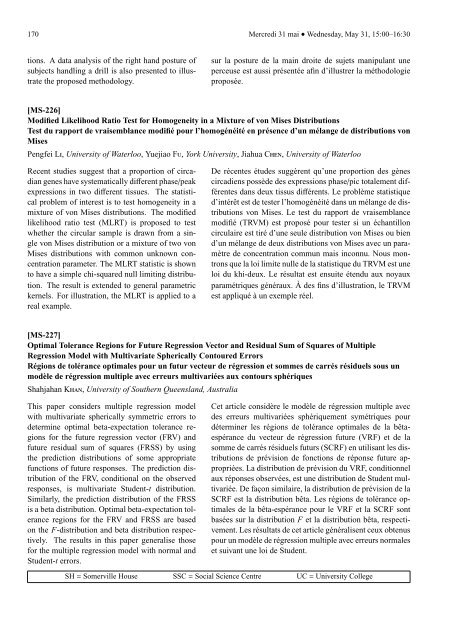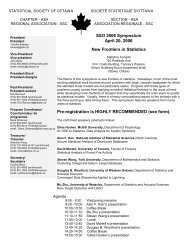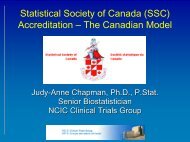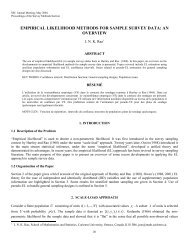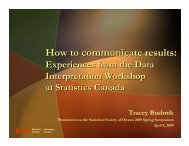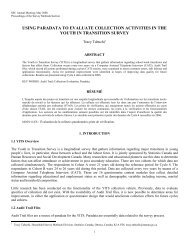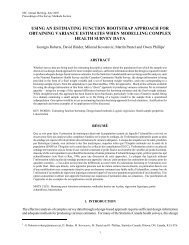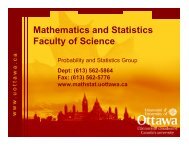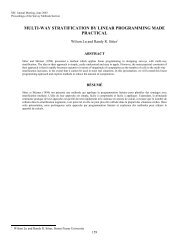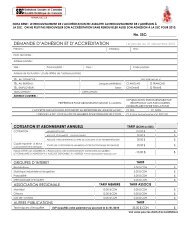Programme et résumés (pdf) - Société statistique du Canada
Programme et résumés (pdf) - Société statistique du Canada
Programme et résumés (pdf) - Société statistique du Canada
Create successful ePaper yourself
Turn your PDF publications into a flip-book with our unique Google optimized e-Paper software.
170 Mercredi 31 mai • Wednesday, May 31, 15:00–16:30tions. A data analysis of the right hand posture ofsubjects handling a drill is also presented to illustrat<strong>et</strong>he proposed m<strong>et</strong>hodology.sur la posture de la main droite de suj<strong>et</strong>s manipulant uneperceuse est aussi présentée afin d’illustrer la méthodologieproposée.[MS-226]Modified Likelihood Ratio Test for Homogeneity in a Mixture of von Mises DistributionsTest <strong>du</strong> rapport de vraisemblance modifié pour l’homogénéité en présence d’un mélange de distributions vonMisesPengfei LI, University of Waterloo, Yuejiao FU, York University, Jiahua CHEN, University of WaterlooDe récentes études suggèrent qu’une proportion des gènescircadiens possède des expressions phase/pic totalement dif-férentes dans deux tissus différents. Le problème <strong>statistique</strong>d’intérêt est de tester l’homogénéité dans un mélange de dis-tributions von Mises. Le test <strong>du</strong> rapport de vraisemblancemodifié (TRVM) est proposé pour tester si un échantilloncirculaire est tiré d’une seule distribution von Mises ou biend’un mélange de deux distributions von Mises avec un paramètrede concentration commun mais inconnu. Nous mon-trons que la loi limite nulle de la <strong>statistique</strong> <strong>du</strong> TRVM est uneloi <strong>du</strong> khi-deux. Le résultat est ensuite éten<strong>du</strong> aux noyauxparamétriques généraux. À des fins d’illustration, le TRVMest appliqué à un exemple réel.Recent studies suggest that a proportion of circadiangenes have systematically different phase/peakexpressions in two different tissues. The statisticalproblem of interest is to test homogeneity in amixture of von Mises distributions. The modifiedlikelihood ratio test (MLRT) is proposed to testwh<strong>et</strong>her the circular sample is drawn from a singlevon Mises distribution or a mixture of two vonMises distributions with common unknown concentrationparam<strong>et</strong>er. The MLRT statistic is shownto have a simple chi-squared null limiting distribution.The result is extended to general param<strong>et</strong>rickernels. For illustration, the MLRT is applied to areal example.[MS-227]Optimal Tolerance Regions for Future Regression Vector and Resi<strong>du</strong>al Sum of Squares of MultipleRegression Model with Multivariate Spherically Contoured ErrorsRégions de tolérance optimales pour un futur vecteur de régression <strong>et</strong> sommes de carrés rési<strong>du</strong>els sous unmodèle de régression multiple avec erreurs multivariées aux contours sphériquesShahjahan KHAN, University of Southern Queensland, AustraliaC<strong>et</strong> article considère le modèle de régression multiple avecdes erreurs multivariées sphériquement symétriques pourdéterminer les régions de tolérance optimales de la bêta-espérance <strong>du</strong> vecteur de régression future (VRF) <strong>et</strong> de lasomme de carrés rési<strong>du</strong>els futurs (SCRF) en utilisant les dis-tributions de prévision de fonctions de réponse future ap-propriées. La distribution de prévision <strong>du</strong> VRF, conditionnelaux réponses observées, est une distribution de Student mul-tivariée. De façon similaire, la distribution de prévision de laSCRF est la distribution bêta. Les régions de tolérance op-timales de la bêta-espérance pour le VRF <strong>et</strong> la SCRF sontbasées sur la distribution F <strong>et</strong> la distribution bêta, respecti-vement. Les résultats de c<strong>et</strong> article généralisent ceux obtenuspour un modèle de régression multiple avec erreurs normales<strong>et</strong> suivant une loi de Student.This paper considers multiple regression modelwith multivariate spherically symm<strong>et</strong>ric errors tod<strong>et</strong>ermine optimal b<strong>et</strong>a-expectation tolerance regionsfor the future regression vector (FRV) andfuture resi<strong>du</strong>al sum of squares (FRSS) by usingthe prediction distributions of some appropriatefunctions of future responses. The prediction distributionof the FRV, conditional on the observedresponses, is multivariate Student-t distribution.Similarly, the prediction distribution of the FRSSis a b<strong>et</strong>a distribution. Optimal b<strong>et</strong>a-expectation toleranceregions for the FRV and FRSS are basedon the F-distribution and b<strong>et</strong>a distribution respectively.The results in this paper generalise thosefor the multiple regression model with normal andStudent-t errors.SH = Somerville House SSC = Social Science Centre UC = University College


